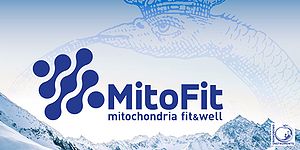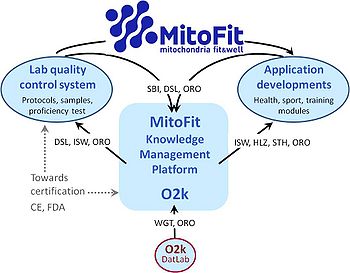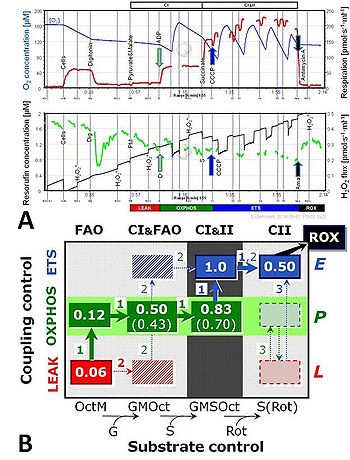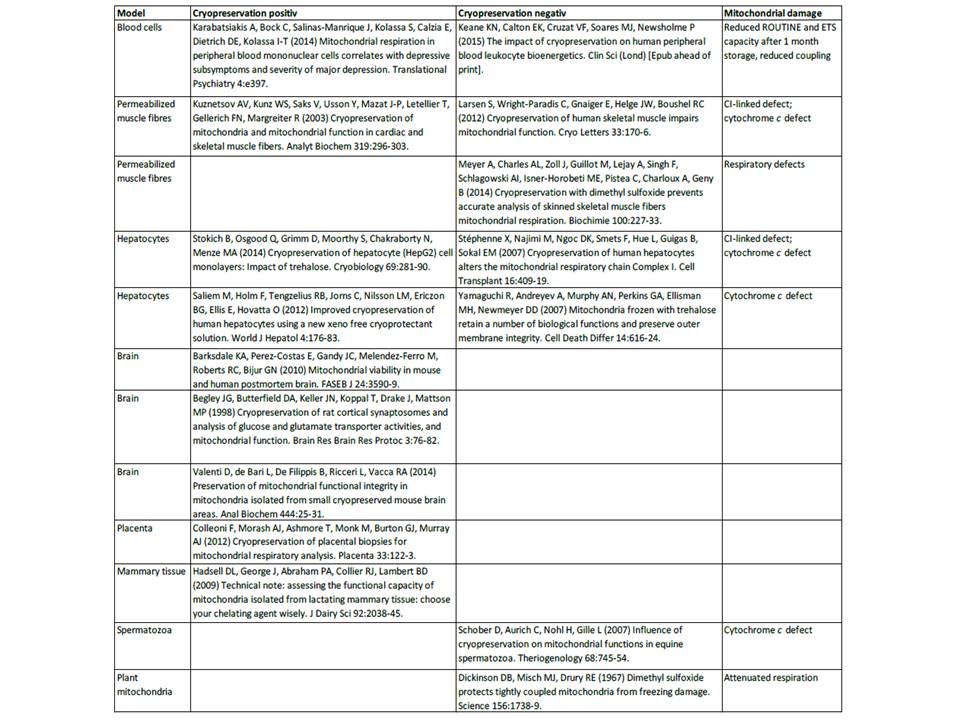K-Regio MitoFit
- Mitochondrial fitness - the new O2k project
What is MitoFit?
The project MitoFit aims at developing a quality control system and knowledge management platform for diagnostic assays of mitochondrial fitness, based on our well established and unique instrument for highresolution respirometry (OROBOROS Oxygraph-2k, O2k). The O2k and O2k-Fluorometer were developed to systematically, routinely and accurately monitor mitochondrial function in basic research and biomedical applications. Novel laboratory standards and diagnostic monitoring of a mitochondrial fitness score - in fresh and cryopreserved cells obtained noninvasively from blood samples - will drive the transition from a specialized research tool to a widely used medical device with a world-wide impact. MitoFit will provide a signature to stimulate health tourism in the Alpine setting, introducing a scientific perspective on the benefits of mitochondrial fitness ranging from outdoor sports to quality of life and healthy ageing supported by physiotherapy.
MitoFit in health and preventive medicine: Physical inactivity is one of the greatest drivers of metabolic dysregulation and preventable diseases in modern societies, and has an impact on ageing populations in particular. It is becoming increasingly apparent that high and robust mitochondrial capacities are central for sustained metabolic health throughout life. Active lifestyles increase mitochondrial capacities and reduce the risk of degenerative diseases. Despite the clear role of high and efficient mitochondrial capacities in preventing metabolic diseases, promoting health and improving life quality in ageing populations, there is currently no regimented, quantitative system, or database organised to routinely test, compare and monitor mitochondrial capacities within individuals, populations, or among populations. The O2k is the only instrument with sufficient stability and reliability for quantitative high-resolution respirometry (HRR). This world-leading technology offers the unique potential for developing the quality control tools required to establish the O2k as a calibrated and standardised in vitro diagnostic device. Overall, we aim to gain a CE Mark and FDA approval for the O2k, following the innovations on the level of a quality control system, and to transform this high-resolution research instrument into an essential medical device to monitor metabolic health – maintaining mitochondria fit and well to live a healthier, longer life.
Concept
MitoFit will provide a unique opportunity within fields of recreation, sports, wellness, lifestyle monitoring and preventive medicine programs. Collaborations with established regional initiatives will leverage on current research initiatives and established expertise in the measurement of mitochondrial function and competence. This will translate to tangible outcomes for the MitoFit concept as a marketable health, sports performance and medical diagnostic device. The establishment of the MitoFit-Knowledge Management Platform with a database reposited in the Centre of Excellence (Fig. 1) will also provide a keystone to support the leadership of the mitochondrial monitoring instruments developed in translational research on mitochondrial competence (e.g. previous K-Regio project MitoCom) in close collaboration with local industrial partners.
The O2k-Core and O2k-Fluorometer, which are the gold standard for generating reliable quantitative respirometric data, will be the instruments of choice to build the MitoFit database. Standardized protocols developed by the MitoFit project will be streamlined for applications of the O2k-MitoFit. This will lead to a significant expansion of the world-wide market for the O2k, and drive the transition of the O2k from a well established specialized research tool to a standard health and biomedical instrument.
Figure 1: Structure of the MitoFit project. The development of the MitoFit- Knowledge Management Platform as an integrated module of the O2k technology system is in the centre of the project is. Strategies will be developed to pave the way towards obtaining a CE Mark (EU) and gaining regulatory approval by the Food and Drug Administration (FDA, US).
Strategy development for hardware and software will be complemented by innovations in laboratory standards. A quality control system unique in the field of mitochondrial respirometry will be developed, from standardized protocols and sample preparation to the world-wide innovation of a proficiency ring test. These developments will be tested and applied in work packages introducing the MitoFit approach into the fields of lifestyle analyses based on diagnostic assays of mitochondrial function in blood cells. Health, sport and training programmes will be developed to improve mitochondrial fitness, with a focus on protective medicine, well-being and healthy ageing. The experience gained in implementing laboratory quality controls and during application developments will provide feedback into the structure and function of the MitoFit-Knowledge Management Platform.
Objectives
The objective is to achieve the transformation for the O2k from a research instrument to a medical device. The O2k is a high-end product for measuring mitochondrial function by high-resolution respirometry and is currently distributed in 42 countries world-wide. In an increasing number of cases, we are faced with demands on CE, FDA or equivalent approval for clinical diagnosis. Presently, there is no other instrument available on the market which meets such requirements. While continuing our strategy on Open innovation to maintain our technological leadership in mitochondrial respiratory research, the objective of the present project is to initiate an additional dimension of Strategic innovation towards standardization and comprehensive quality control as required for a medical device.
Technological and scientific innovation
The MitoFit-Knowledge Management Platform will be developed as an integral component of the O2ktechnology. It will provide the first standardized measures to link human mitochondrial health to physiome data (heart rate, BMI, blood pressure, blood chemistry, VO2). The technological ‘sole source’ status will be systematically secured. An increasing amount of respirometric data on mitochondrial physiology is generated world-wide, enlarging the theoretically available data base at an increasing speed. However, due to lacking standards as to how results are reported, most published data are not available for quantitative meta-analysis. Even within reserarch groups, data from different projects have to be tediously re-analyzed for quantitative comparison. By extending O2k applications to monitoring personal mitochondrial fitness and diagnosing an increasing range of health conditions, the development of a knowledge management platform will become even more important and mandatory for considerations on CE and FDA approval. The design of the MitoFit-Data Management System will provide the conceptual framework for strategic innovations related to a quality control system for standardization of instrumental quality tests and mitochondrial reference protocols, establishment of reference samples for proficiency tests, and guidelines for data analysis and presentation. Based on a collection of data obtained through this platform, users will be able to search from pre-defined fields or through full-text search for data, documents and a variety of areas of interest. In combination with web-based collaboration tools implemented in the software, the platform will both broaden the actually available data base for all researchers and stimulate the development of research networks.
Reference sample of cryopreserved mitochondria: The development of a reference sample for respirometry will provide enormous benefits for scientific research and open up new perspectives on clinical applications, enabling a presently unattainable level of quality control in respiratory studies which will (1) increase the scientific potential of on-going and newly initiated mitochondrial studies in basic and applied research. (2) The reference sample will provide the possibility for quality control of quantitative data for direct comparison and evaluation of functional mitochondrial diagnosis on patients monitored over the timecourse of their disease and treatment, and diagnosed by different clinical laboratories. (3) A reference sample can contribute significantly to the substitution and reduction of experiments with sacrificed animals, by (a) replacing animal tissue used for training and routine quality control, or (b) for methodological development, and (c) reducing the number of artefacts in experiments with animal or human tissue by detecting methodological deficiencies in routine quality control using the reference sample.
Cryopreservation of human blood cells: Obtaining tissue biopsies for the study of mitochondrial function is an invasive approach that requires a clinician to obtain the samples under strictly sterile conditions and that usually goes along with the need to immediately use the samples for measurements. The possibility to measure mitochondrial function in human blood cells will help to overcome these limitations by allowing a far less invasive sampling procedure applicable by anyone proficient in blood drawing and by enabling the collection and storage of samples for later measurements and analysis. It will also allow the repeated sampling of the same individual, as the burden of sampling is dramatically reduced. Altogether, the advantages of using cryopreserved human blood cells for respirometry will immensely widen the applicability of respirometry for the study of human physiology and will provide a significant stimulus for the entire research field.
MitoFit proficiency test: A proficiency ring test, probing the performance of participating laboratories, will be applied using the reference samples developed in a previous step. Measuring the respiration of reference samples at two pre-defined time points and following strictly defined experimental protocols, it will be possible for the first time to evaluate and compare the proficiency of different labs and to assess the reproducibility of measurements conducted, thereby having a measure of quality control at hand. Based on the outcome of the test, individual labs may set adequate steps to improve their performance and to develop lab SOPs supporting compliance with defined standard requirements.
Current state-of-the-art
Knowledge Management Platform: Many research groups are working on extensive documentation of genetic, epigenetic, transcriptomic, proteomic, lipidomic and metabolomic datasets in basic and clinical research, including mitochondrial medicine. Relevant techniques include next-generation sequencing to determine the genome (nDNA and mtDNA), methylome, and transcriptome (RNA), and mass spectrometry (proteome, lipidome, K-Regio: MitoFit 4 MitoFit www.mitofit.org metabolome). Such data are available online through various portals, some of which provide Open Access to allow researchers to use the data for addressing their specific interests and working hypotheses.
The capacity and efficiency of energy transformation through the mitochondrial pathways of core energy metabolism represent key features of the mitochondrial phenotype, but no corresponding data base is available for mapping mitochondrial health versus disease in humans. Performance parameters of OXPHOS are not available in a consistent format for cataloguing and, therefore, are not represented in presently available databases. Quantitative comparability of data generated by different labs on OXPHOS performance is restricted due to different protocols applied for preparing experimental solutions (solution protocols) and lack of standardization of procedure protocols including instrumental performance protocols, mitochondrial and cell preparation protocols and experimental titration protocols (SUIT protocols; Fig. 2).
With more than 280 and 150 O2k instruments sold in the EU and the US, respectively, it appears that we are not required to obtain a CE Mark or FDA clearance or approval for the O2k. However, this status will change when extending the applications from a research instrument to a medical device intended to report personal mitochondrial fitness disposition results for a wide range of health conditions, including the propensity for degenerative and other complex diseases. According to our knowledge of the available literature, the OROBOROS O2k is the only instrument on the world-wide market providing system accuracy criteria compatible with implementation of a Quality Control System for use as an In Vitro Diagnostic (IVD) device.
Cryopreservation: The current lack of a reference sample offering sufficient stability of respiratory parameters (intact mitochondrial membranes, preserved mitochondrial respiratory capacity, coupled oxidative phosphorylation) during storage has so far prevented implementation of proficiency testing. Application of stabilizers such as dimethylsulfoxide and polyethylene glycol yields controversial results on preserving mitochondrial function (Tab. 1). Mitochondrial respiratory competence has been reported in mononuclear human blood cells directly after storage at -80°C (Karabatsiakis et al 2014). Since cultured cells are routinely stored at -80°C and cultured after thawing, it appears most promising to optimize conditions for cryopreservation of respiratory functions in a selected mammalian cell culture.
Assessing fitness and performance in humans: Standardized protocols are available to assess physical fitness by performance testing of athletes and patients, e.g. with spiroergometry for monitoring the success of training or therapeutic interventions (WP 7). In addition, biomarkers in blood samples are commonly monitored for risk evaluation (glucose tolerance test, HbA1c, ß-cell function and insulin resistance, triglycerids, cholesterol – TC, HDL, LDL), inflammatory processes (C-reactive protein, IL-6 and TNF-alpha) and disturbances of oxidative balance (derivatives of reactive oxygen metabolites; biological antioxidant potential test). Available blood tests providing an index of mitochondrial function are limited by over-simplified protocols, low resolution and controversial interpretation (Chacko et al 2014). Respirometric SUIT protocols for OXPHOS analysis (Sjoevall et al 2010, 2013, Pecina et al 2014) need to be extended by combined measurement of hydrogen peroxide production to provide additional information on mitochondrial-specific oxidative stress (De Lucas et al 2014).
Diagnostic evaluation of cryopreserved samples: Karabatsiakis et al (2014) collected blood samples from patients diagnosed for major depression, separated peripheral blood mononuclear cells and froze these cells in a standard culture freezing medium for cryopreservation at -80 °C. Cells were subsequently thawed and examined by HRR. ROUTINE respiration, electron transfer system capacity and coupling efficiency were diminished, in direct correlation with the severety of major depression. With this group as an International Strategic Partner, this approach will be extended for application to life style diagnostics in preventive medicine.
Figure 2. Substrate-uncoupler-inhibitor titration (SUIT) protocols.
A: Combined determination of oxygen consumption and H2O2 flux by O2k-Fluorometry in permeabilized HEK cells. Substrate and coupling states are shown in the upper and lower bars. Substrate states are limited to CI- and CI&II-linked respiration. From Makrecka- Kuka et al (2015).
B: Coupling/substrate control diagrams for experimental protocol design, including multiple substrate states for fatty acid oxidation, FAO (octanoylcarnitine & malate, OctM), CI-linked (addition of glutamate, G), CI&II-linked (addition of succinate, S), and CII-linked (addition of rotenone, Rot) respiration. Flux control ratios are normalized relative to ETS capacity with convergent CI&II (&FAO) electron input. Arrows 1, 2 and 3 indicate different SUIT protocols with partially overlapping respiratory states. From Gnaiger (2014).
Table 1:
Partners
- MUI: Universitätsklinik für Visceral-, Transplantations- und Thoraxchirurgie, D. Swarovski Forschungslabor, DSL (Ao. Univ.-Prof. Dr. Erich Gnaiger)
- MUI: Biozentrum Innsbruck - Sektion für Bioinformatik, SBI (Univ.-Prof. Dr. Zlatko Trajanoski)
- LFU: Institut für Sportwissenschaften, ISW (Univ.-Prof. DDr. Martin Burtscher)
- KMU: OROBOROS INSTRUMENTS GmbH, Innsbruck, ORO (Dr. Erich Gnaiger, Mag.a. Verena Laner)
- KMU: WGT-Elektronik GmbH & Co KG, Kolsass, Tyrol, WGT (Philipp Gradl)
- KMU: Höhenleistungszentrum Betriebsg.m.b.H., Innsbruck, HLZ (Geschäftsführer Mag. Andreas Brix, Robert Valentini)
- KMU: Sporttherapie Mag. Huber GmbH, Innsbruck, STH (Mag. Reinhard Huber)
External consultants
- MUI: Department für Medizinische Statistik, Informatik und Gesundheitsökonomie, MSIG (Univ.-Doz. Dr. Georg Göbel)
Market prospects
Effects of the project on the participating companies
The cooperation between the two companies ORO and WG has been ongoing successfully for more than 12 years, with WGT as the contractor and ORO as the client assuming all financial risks. The development of the concept for the transformation of the Oxygraph-2k from a research instrument to a biomedical device will extend the previous collaboration to establish a development partnership and lead to an extension of the possible market. ORO and WGT will collaborate within the K-Regio project as partners with shared investments and shared risks. HLZ and STH are partners in the development of application products, which are required in order to define the needs of applicants using the O2k-MitoFit after the successful transformation to the biomedical device.
By reducing the investment risk through a K-Regio project, a collaborative technologically and scientifically demanding R&D project will be possible. Accordingly, based on previous long term continuing development of the O2k which was at our own initiative and in response to economic success, a market-orientated leap in technology with excellent prospects seems achievable. In the medium term, the transformation for the O2k to MitoFit-O2k (i) will provide the basis for a market expansion both internationally and in the domestic markets and (ii) will aid in the further expansion of the worldwide leading position which has been achieved technologically with the O2k in the mitochondrial physiology sector on a research basis. So far, no other respirometer has been certified as a biomedical device, which will lead to technological leadership and open a broad market.
The two companies (ORO and WGT) are thus well prepared for initiating the present R&D project. However, evaluation of scientific applications by potential end-users of the new O2k-MitoFit (in this project HLZ and STH) is required to verify their needs.
The cooperation with and between the Tyrol Universities in mitochondrial physiology (sport and clinical applications) will lead to the development of methodological protocols for the new instrument which, in our experience, are a decisive factor in the launch of the products onto the market by ORO and furthermore mandatory for the medical device.
The worldwide need for a biomedical device applicable for diagnosis of mitochondrial dysfunction is by far greater than that for respirometric applications of the O2k in research which has been successful in the world market. This development will expand job opportunities in the production (WGT), strengthen the mutual competence for innovative and technically complex developments and provide a new stimulus for export (ORO).
Upon successful conclusion of the K-Regio project, the number of devices sold is expected to increase substantially, from currently 90 instruments per year to 130 units per year, resulting in an additional turnover of expected 1.2 Mio. Euro. A prerequisite is that the speedy achievement of the development resulting from the support of the project can immediately be converted into a launch onto the market before a competing device will be certified as a medical device and offered internationally. This will lead to a significant expansion of the worldwide market for the O2k in the transition from a well established specialized research tool to a standard biomedical instrument.
WGT benefits from the future production of the new instrument. The comprehensive approach of this project makes possible instrumental design in close contact with highly specialized scientists experienced in instrumental development (ORO) and directly embedded in the applications of the company partners (HLZ and STH) in cooperation with academic partners (MUI and LFU).
The development of new sports products will help the HLZ to create new products and will strengthen their international position in competition with other high altitude training centres and allow a financially more balanced tourism. For the company STH, the possibility to not only provide physiotherapy but to also evaluate the effectiveness of the intervention with sophisticated scientific means is likely to enhance both its reputation and attractiveness. This will allow physiotherapists to constantly develop therapies towards increased effectiveness at possibly diminished time requirement.
The participating companies could never accomplish such an ambitious task without the financial and personal support from the K-Regio project with the consortium of MitoFit. The project will provide a cornerstone for the leadership of the mitochondrial monitoring instruments developed and marketed by OROBOROS INSTRUMENTS.
Effects of the project on the participating research institutes
The D. Swarovski Research Laboratory will profit from gaining access to samples from the high-altitude training and physiotherapy studies. Researchers will significantly broaden the database on respirometric characteristics of different cell types in humans with differing lifestyle background, i.e. athletes, sedentary and active elderly persons. Furthermore, members of the D. Swarovski Forschungslabor will co-author relevant publications.
The Division of Bioinformatics (SBI) has a long-standing expertise in software and database development for the life-sciences but so far no experience in integrating biomolecular and high-resolution respirometry data. This project will expose SBI to a highly exciting research field and broaden their expertise. By integrating genetic and high-resolution respirometry data, SBI expects to position the lab at the fore-front of the field of metabolic research on important human diseases. In addition, the SBI will be at the heart of the development of a completely novel research platform potentially linking hundreds of research groups, ranging from cell biologists to sport scientists and clinical psychologists. This project could thus significantly elevate the reputation and international visibility of the department and provide them with the possibility to develop tools for the handling of huge and diverse data sets from all over the world, thereby shaping and testing novel ideas on data management in a timely and important context.
The goals of the present project perfectly match those of the Institute of Sport Science, enabling the investigation of health and training effects at low and high altitude under real life conditions. In addition, the ISW will be able to extend their research tools and skills (mitochondrial function testing) and potential collaborative partners for future studies. Participants from the ISW will gain access to state-of-the-art technology (combined respirometry and fluorometry) and expert scientific support for the application by the developers of the instrument. Applying these techniques in combination with established performance tests of sport science, it will for the first time ever be possible to correlate and functionally link changes in fitness with alterations in mitochondrial physiology of human blood cells. Furthermore, by comparison of these cells with muscle biopsies obtained from a subgroup of participants, the hypothesis can be tested that training-induced changes reflected in altered physiological characteristics of muscle fibres are also manifested in blood cells. The explicit testing of this hypothesis is likely to produce a key publication in the field of sport science.
With publications resulting from the studies in the K-regio MitoFit project, the Universities will strengthen their international reputation on the related fields. All academic partners will benefit directly and indirectly from the K-Regio project. It will have a high visibility in the international field, stimulate scientific and clinical projects and further collaborations at the partner universities, and attract experts and motivated students.
Regional Impact
Direct economic impact
5 positions (4 PhD, 1 biomedical scientist) will be created for highly qualified researchers in the academic partner institutes for the duration of the project, and 2 fulltime equivalents in the participating companies. For permanent staff involved in the project, see Appendix III – Explanation of external costs and permanent staff involved. Currently approx. 25 positions in Tyrol depend on the success of the O2k. By certification of the O2k as a medical device, the expected increase in sales will lead to the creation of further jobs in production and sales sectors: 5-6 additional positions at ORO and 2-5 posts at WGT could be financed. The work places related with production and marketing of the O2k will be assured for years as a result of the improved competitiveness. The project MitoFit is expected to strengthen tourism in Tyrol. The HLZ already collaborates with 50,000 sports clubs in Central Europe, among them approx. 5,000 soccer clubs. Through the sports and health programmes of MitoFit, an intermediate of 3,000 additional overnight stays per year is expected in the project area, corresponding to an annual turnover of EUR 250,000.-.This way, the establishments in the project area develop more and more towards a year-round opening, which creates highly valuable year-round posts.
Becoming ‘mitofit’ – a trend towards a new lifestyle?
A successful conclusion of the project with validation on the live high train low concept (WP 7) will help the HLZ to advertise for stays and trainings in Kühtai and attracting more sport athletes. Mitochondrial knowledge will, with its innovative approach, arouse a new awareness of preventive medicine, to which a physically active and caloriebalanced lifestyle can contribute significantly. Of particular importance is “healthy aging”, a generally improved quality of life and a reduced risk of a multiplicity of degenerative diseases influenced by the mitochondria: e.g. obesity, diabetes II, various forms of cancer and dementias. Mitochondrial competence will be made a reality to a larger proportion of the population and the regional identity strengthened both amongst our own population and amongst tourists through the offer of exercise-orientated leisure packages in the Alpine landscape of Tyrol. Making our mitochondria fit – MitoFit and well – may strengthen the trend to a less sedentary, healthier and balanced lifestyle, supported by the growing evidence of the central role of mitochondrial function for an improved and prolonged quality of life.
Articles
Click here for some of our articles conerning the new projekt MitoFit
Meetings
Meeting 2015-02-03
- Programm » O2k-MitoFit Programm 2015-02-03
Former Projects
MitoCom O2k-Fluorometer: » MitoCom_O2k-Fluorometer







